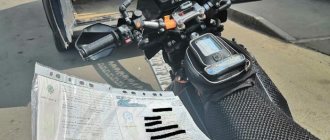Until the 80s, homemade cars could be driven without registration. Now, having designed your own vehicle or converted an existing old car, you cannot drive it around populated areas, give it away or sell it, which is why the owner needs to know how to register homemade cars. In 2005, it was impossible to register a homemade vehicle; the Supreme Court of our country outlined the limitation by the lack of specific rules for hand-assembled units that need to be determined. In fact, in this way they fought against “construction kits” (machinery parts imported from abroad, with subsequent assembly and registration as home-made products in Russia), which made it possible to avoid taxes on imported vehicles (cars, trailers).
The ban did not prevent manufacturers from constructing home-made cars, despite the impossibility of operation. Hand-made vehicles could be seen at the Autoexotica exhibition. To show off their creations, owners had to deliver their cars using a tow truck. Since 2015, the car enthusiast has the opportunity to register and subsequently operate it, but must be prepared that the stages will take time and money.
Basic requirements for a homemade trailer
You can register a single vehicle only after the testing laboratory has given the go-ahead.
Before going to this place, you need to find out what requirements the model must meet:
- Dimensions. Length – no more than 12 meters, height – up to 4 meters, width – no more than 2.5 meters. The total length of the vehicle and trailer must not exceed 18.3 meters.
- Weight. Light category – up to 750 kg. In this case, brakes are not needed. Medium category – up to 3500 kg maximum weight. Inertia brakes will do. And the last group with a mass of no more than 10,000 kg requires permanent brakes.
- Another important parameter is the wheels. Some must be the same in size, structure, and characteristics. Tread depth – up to 1.6 millimeters. It is also worth paying attention to the fact that trailers, starting from the middle category, need to change tires depending on the season. From December 1 to March 1 - winter, in the warm season - summer.
To register a light trailer, laboratory staff will primarily pay attention to markings and lighting equipment. To check a larger transport unit, it is necessary to have a brake system and a test report. For trailers with maximum weight - anti-lock brakes.
Certification standards
To register a homemade car, you first need to be certified. The requirements defining the procedure are approved in the corresponding order of Rostekhregulirovaniya. Now cars are evaluated according to a simplified scheme - as a vehicle that is produced in “small series”. A small series means a single copy of a machine.
This is a little trick of the state, with the help of which it was able to get rid of the import of so-called designers. The number of cars in a small batch is carefully checked. It is clear that the author of a homemade car that he assembled for himself will not produce more than one vehicle of the same type. Thus, it is no longer profitable for someone involved in industrial assembly to work according to such a scheme. It is not possible to go through the certification procedure again.
European requirements
The requirements for home-made cars are no lower than the standards established for production cars. There are no “indulgences”; in addition, such vehicles must comply with the standards of the Economic Commission for Europe. True, certification of small batches is carried out according to a reduced list of requirements. However, this is still a fairly serious procedure that not all homemade products undergo.
The video shows a homemade Ukrainian sports car:
In accordance with a document approved by the European Commission, vehicles are checked for compliance with the following requirements:
- traumatic safety of the steering wheel;
- braking performance;
- reliability of seat belts and their attachment points;
- the quality of glass and rear-view mirrors, as well as the correctness of their installation;
- availability of lighting devices, light signaling;
- good machine controllability;
- high car stability;
- low level of harmful substances in the cabin;
- low internal noise level;
- low level of harmful substances in the exhaust pipe.
All these requirements apply to passenger cars manufactured independently.
Stages of registering a homemade trailer
- The first step is to obtain a certificate from the laboratory, according to which the homemade model meets all the rules set out in the law. A referral for examination can be obtained from an inspectorate employee upon initial contact with the traffic police department. An application is also made there.
- When submitting a referral to a laboratory technician, you will be asked to attach all receipts spent on the purchase of materials for production. In the application, which the owner will be asked to fill out, you must indicate all the names of the spare parts from which the frame was made. Write that the welder who welded this frame has residual qualifications for such employment (has permission to carry out the relevant work). Attach a photo of the entire trailer, as well as a close-up of the hub assembly.
- Now the owner must wait for the data to be reviewed by the laboratory. If employees do not find any deviations, they will issue a certificate and certificate.
- With these documents you will have to go to the traffic police again, write a statement, show the trailer to the inspector so that he can check the actual numbers with those indicated in the documents.
- The last step is to pay the state fee and receive documents.
The whole process takes a lot of time and effort, as well as material resources.
Order
Before registering a car, you must obtain a certificate of conformity from a special center. The car will be checked for safety.
To evaluate a car, you need to submit an application to Rostekhregulirovanie. On the website of this organization you can find a center where certification will take place.
Additionally, for inspection you must provide:
- a statement indicating the distinctive features of the car;
- design documentation;
- technical description of homemade transport.
The homemade vehicle will be assessed for:
- compliance with environmental standards;
- noise level;
- performance of the brake system, steering;
- security;
- vehicle sizes.
When checking a homemade car, its owner may be refused if the vehicle does not meet the requirements of the UN Economic Commission for Europe.
Checking a homemade car is carried out according to a simplified procedure, but this does not mean that the requirements will also be less. In addition to the above, the car will be checked for stability and controllability, for the presence of harmful substances in the cabin and in the exhaust, and for the quality of fastenings.
However, among all these stringent requirements, a pleasant moment has appeared for the owner: according to the new crash test program, which has been amended, now when checking a car, the list of tests that could cause damage to the car is excluded.
If the car has already been certified, but the issuance of a certificate was refused, it is necessary to provide a list of the design changes made when applying again.
This means that re-passing the certification procedure is possible only if the reasons that led to the refusal the first time are eliminated.
It is necessary to obtain a conclusion from the Institute for Road Safety that the car is safe to travel and that the design itself does not violate established standards. The certificate is issued within a month from the date of submission of the relevant application.
After receiving the certificate, you can obtain a resolution from the MREO stating that your homemade vehicle does not have an identification number.
With this document, you need to contact the forensic bureau to receive a referral to the traffic police to assign an identification number.
To do this, you need to prepare the following documents:
- passport of a citizen of the Russian Federation;
- expert opinion from MREO.
After this, the car will be assigned an identifier, and a conclusion about the number will be issued. After applying the number to the homemade car, you need to contact the MREO for registration.
Now you can submit documents to register your homemade vehicle. After reviewing the documents provided, the traffic police officer will issue a passport for him.
A home-made vehicle will be registered as a regular car, and in the “car make” column it will be written “home-made”.
If the traffic police authorities refuse registration, it is necessary to resolve the issue in court by contacting the local administrative court at the place of registration of the owner or the traffic police department.
Required documents for registration
You can save time if you find out in advance what package of documents is required to apply for registration of a homemade trailer.
The full list includes:
- Passport of a citizen of the Russian Federation.
- Copies and originals of receipts that are issued when purchasing materials for the manufacture of a transport unit.
- Detailed explanation of the model design.
- Photos (from all angles, size 10×15, 4 pieces).
- Receipt indicating payment of the duty.
- A completed application submitted to the MREO.
Restrictions
Self-made cars made from components that were imported into the Russian Federation for more than six months are not subject to registration. They must be provided with appropriate documents confirming the legality of their appearance on the territory of the country. All of them must be certified. If you make any changes to the design of your registered vehicle, including the design of its components, spare parts and additional equipment, you will have to go through the certification and declaration of conformity procedure again.
Registration through the State Services portal
Registration via the Internet will significantly reduce time and money. It can be done on the government services website in several stages:
- Select the “Vehicle Registration” section.
- Select the “Register” category.
- Follow the “Registration” link.
- Log in.
- Fill out an electronic application that contains document data.
- Select from the list a date and time acceptable to the applicant when he can personally visit the inspector, and decide which department he will go to.
- Submit your application for consideration. If all information is correct, it will be approved.
- Pay the state fee, which comes with a 30% discount.
- Download and print the payment receipt, as well as the completed application form.
- Arrive at the MREO on the specified day along with documents, an application form and a receipt. There is no need to stand in line; the inspector will call you.
- An employee will check the trailer, which must be located next to the department. Make sure your transport is clean in advance.
- After the last procedure, you can receive a registration certificate and license plate on the same day.
As you can see, when submitting an electronic application, you do not need to visit the laboratory yourself, personally visit inspection staff several times, fill out applications manually, or stand in long lines. A few mouse clicks – problem solved!
Mandatory provisions
Registration of a homemade car was not always mandatory. New provisions affected the automotive sector in 2015. Before the onset of the eighties of the last century, it was allowed to travel in cars that were assembled by craftsmen with their own hands. The movement was carried out without any documentation. After this time, a law was adopted indicating the need to carry out registration actions regarding transport.
These provisions applied to the following structures:
- maximum power did not exceed 50 horsepower;
- Limit dimensions have also been established, which should not exceed 1.8 * 4.7 meters.
If the car does not meet these parameters, there is no need to register. The design of the car did not affect the process under consideration. It is worth noting that during the specified period of time it was possible to find a loophole so as not to register the car.
Speaking about how you can register a home-made vehicle, it is worth pointing out that they further established a ban related to the impossibility of assembling a car from those parts of the car that were previously installed on production models. These vehicles remained unregistered. Passenger cars and other vehicles could be assembled from parts of non-standard meaning. These provisions were established in 2005.
In 2015, the legislator established the need to carry out registration actions regarding homemade cars. It is mandatory to register your transport. This allows you to use the car for its intended purpose. They often write on forums that it is impossible to drive a home-made product if registration has not been completed - this situation is true. In this case, the weight of the car must correspond to what is reflected in the laws.
Trailer registration fee
When registering a homemade trailer, you will not need to overpay for detaching the transport unit from the previous owner in order to assign new signs. The state fee for issuing new license plates for 2021 is 1,500 rubles, for issuing a certificate - 500 rubles. You will also have to pay for the examination. Its cost depends on the specific accredited laboratory.
You can save money if you make an appointment with the traffic police online through the State Services portal. The discount will be 30% . The issuance of registration plates for trailers is 1050 rubles , the registration certificate will “cost” 350 rubles .
Actions in case of failure
In case of refusal of registration, the owner's course of action depends on the reasons for such a decision. If the information provided is incomplete or unreliable, the deficiencies should be corrected and the traffic police should be contacted again.
When an interested person believes that his rights have been violated, he can contact the higher management of the inspectorate or the supervisory authority. If this does not give the desired result, then a statement of claim should be sent to the court.
Penalty for using an unregistered trailer
Each driver will have to register a trailer if he intends to use it. Otherwise, you may run into punishment from inspectors.
What penalties are provided in this case:
- If a traffic police officer is caught using an unregistered trailer for the first time, you will have to pay up to 800 rubles, depending on the severity of the violation. The higher the mass of the transport unit, the heavier the punishment.
- If there is a repeated offense, no one will make concessions. Your wallet will be empty by a large amount (up to five thousand rubles).
- Pernicious violators will face not only a fine, but also a restriction in driving. The court may impose a period of up to 3 months of deprivation of a driver's license.
Do I need to deregister a homemade trailer?
Today, when selling a trailer, there is no need to deregister it even when purchasing it. This can be done, but you will have to pay a certain amount for the state duty, drive the transport unit to the parking lot for inspection by an inspection officer and many other nuances.
Therefore, car enthusiasts prefer to simply write a power of attorney for the other owner and have it notarized.
If the new owner decides to install other registration marks, he will bear all the costs himself and receive documents by proxy, that is, the participation of the previous owner will not be required.
A homemade trailer is a little more complicated to design than a factory-purchased one. Before registration, it should be tested for safety in a special laboratory.
Only after the certificate is issued by this institution will the procedure become standard. In order for laboratory technicians to approve registration, the trailer must meet the requirements described in the article.
Didn't find the answer to your question? Find out how to solve exactly your problem - call right now: +7 (Moscow) +7 (812) 309-53-42 (St. Petersburg) It's fast and free!
Free online consultation with a car lawyer
Didn't find the answer to your question? Find out how to solve exactly your problem - call right now: +7 (Moscow) +7 (812) 309-53-42 (St. Petersburg) It's fast and free!
Step-by-step instructions for obtaining certification
The certification stages include:
- Collection of necessary documentation.
- Contact an organization that has the right to carry out activities of this nature.
- Vehicle testing.
- Obtaining documentary evidence of certification.
It should be remembered that you may be denied your application if inconsistencies with the requirements of technical standards are identified during the assessment process.
Where to contact?
To certify a home-made car, you need to contact a company that has received accreditation from Rosstandart. The owner can undergo the procedure in any organization located in the country. The place where the equipment was manufactured or where the owner was registered does not matter.
Documentation
The basis for evaluating equipment is the owner’s statement. It should indicate the following:
- Name and address of the special center.
- Information about the owner of the car - last name, first name, patronymic, place of residence, passport details.
- Information about the vehicle - when it was made, color, dimensions, engine power.
- The request for testing itself.
- List of attached documentation.
- Date and signature of the applicant.
The initiator's passport must be attached to the application. In addition, you must submit technical documents for components and assemblies, as well as checks, receipts and agreements for their purchase.
When using an old body or spare parts, you need to prepare a certificate of deregistration of the car.
How is the procedure performed?
Since the homemade equipment cannot be used until the assessment is completed, it will need to be transported to the center using a tow truck. After this, the company’s specialists will conduct a detailed inspection and testing of the car. The following will be checked:
- Correct installation of the steering wheel, seat belts, brakes and rear view mirrors.
- Compliance of exhaust gas levels with established standards.
- Presence of harmful substances inside the cabin.
- Noise level.
- Sustainability of technology.
- Availability of light alarm.
The car will also be placed in a special device, with which you can check the operation of all systems.
What is given after passing it?
Based on the results of the testing, a written conclusion is drawn up. It is drawn up in the form of a protocol. It states the following:
- Date and location.
- Name of the center.
- Information about the car.
- Type of testing.
- The results, that is, whether the equipment meets the standards or not.
- Expert opinion.
- Signature of a specialist.
The protocol along with the certificate is handed out to the applicant. The certificate is issued on the center's numbered form and certified by the company's seal.
Is it possible to get a refusal and what to do in this case?
The interested party must be prepared for the possibility that his or her application may be refused. This is possible if the equipment has not passed the test, that is, it does not meet the established standards. In such situations, you will have to eliminate the identified deficiencies and contact the center again. If the initiator does not agree with the refusal, he has the right to file a statement of claim in court.










